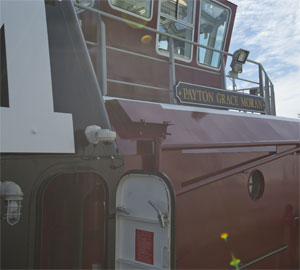It’s a proven pedigree, a mix of muscle and maneuverability with a wide beam for greater stability at higher speeds. Add a tweak here and a tweak there and you have Payton Grace Moran, the latest in a line of powerful tugboats from Washburn & Doughty for Moran Towing.
The 93-foot tug features a 38-foot beam, a design that the Maine shipyard rolled out in 2011 with James A. Moran, which works the waters of Savannah, Ga. Payton Grace Moran, the eighth boat in the series and the fourth for Moran, departed East Boothbay in March for duty in Norfolk, Va.
The new tug joins brother George T. Moran in Norfolk and brings the same formidable specifications to bear. Propulsion is provided by a pair of 3,000-hp EMD 12-710 main engines with Schottel z-drives turning 102-inch propellers in nozzles. Two John Deere 99-kW gensets handle the auxiliary power. The system produces a bollard pull of 68 metric tonnes and a speed of 14 knots.
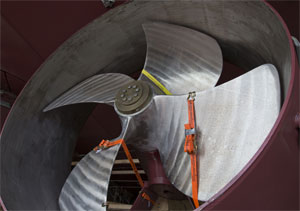 |
|
One of Kirby Moran’s 102-inch propellers. |
Moran crews in Norfolk wondering what to expect from the boat can look to the experience of colleagues in Port Arthur, Texas, where Hayley Moran — the fourth tug in the series — entered service in 2014.
Capt. Jeff Welsh said Hayley Moran is the most powerful tug in Port Arthur and is able to assist any vessel, “from loaded 150,000-dwt oil tankers to large bulk and chemical vessels to ATBs.” It is one of five Moran tugs serving the area.
“Where Hayley Moran truly excels is working on line off the centerline aft of a loaded oil tanker,” Welsh said. “The wider beam of the tug allows her to track well behind the ship and not be rolled by the ship’s wash. The tug is a great blend of engines, drives, wheels and hull design, all while providing incredible maneuverability.”
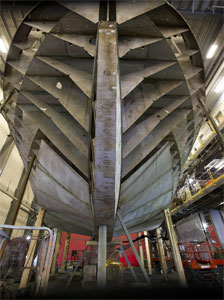 |
|
The hull of James Moran takes shape. |
Welsh said other benefits for captains of tugboats in the series include larger windows for improved 360-degree visibility; an improved render and recover winch that allows for complete control of the towline from the wheelhouse; and a camera system for monitoring the engine compartments and deck area as well as the interior of the boat.
For the crew, the wider beam means more comfort in the accommodations space. A tour of Payton Grace Moran at the Washburn & Doughty dock showcased the extra room and provided a look at features that make life on the water more like life at home. Among them are cable TV and ethernet in all four staterooms (the boat has berths for seven crewmembers); a large flat-screen TV in the galley; separate Mitsubishi climate-control panels in each room; and a washer/dryer unit. The boat has three heads and two showers.
Moran has upgraded the accommodation lights in Payton Grace Moran to LED fixtures, with the lights stylishly recessed in the galley. Navigation lights and floodlights are also LED. Previous boats in the series have incandescent lights.
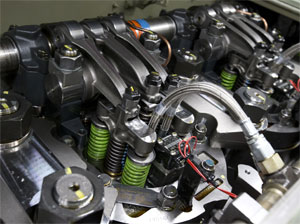 |
|
Payton Grace Moran’s 38-foot beam provides plenty of space to access the tug’s twin EMD 12-710 diesels |
“The LEDs are much brighter, almost like daylight, and they use less energy,” said Matt Maddox, vice president of finance and business development at Washburn & Doughty.
To reduce sound and vibration, the main engines are soft-mounted and acoustic ceiling tiles have been installed throughout the accommodations space. The flooring includes Soundown urethane foam strips under fireproof plywood and Endura tiling to further isolate noise.
“Having that and other dampening makes that space a lot more quiet. You’re right over those large engines, but you hardly know they are there,” Maddox said.
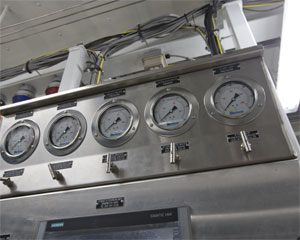 |
|
Payton Grace Moran's engine control panels. |
Up in the wheelhouse, Payton Grace Moran sports twin Furuno NavNet 3D radars and electronic chart displays. The navigation package also includes a Furuno FA150 AIS transponder, a Ritchie Globemaster YB600 magnetic compass and a Furuno SC30 satellite compass. An Icom 604 provides the crew with VHF radio communications.
There are a few tweaks in the wheelhouse from previous boats in the series. The aft windows have been fitted with a hot-air defogger, audio is now recorded full time instead of only when the VHF microphone is keyed, and high-grip, high-visibility treads have been installed on the stairs. The new treads can be seen elsewhere on the boat as well.
Out on the bow deck, Payton Grace Moran is equipped with a 50-hp Markey DEPC-48 hawser winch that can handle 400 feet of 9-inch line. Aft of the wheelhouse is a Markey CEW-60 two-speed electric capstan.
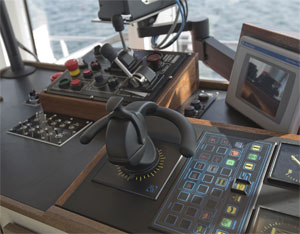 |
|
The user-friendly layout in the wheelhouse features mostly Furuno electronics. |
Moran Towing plans to have nine more tugs of the same class delivered by Washburn & Doughty through the middle of 2017. The next two boats are Kirby Moran and James Moran. Home ports for the new vessels had not been determined at press time.
“When Moran entered this latest newbuilding program we did so to address what we expected would be ongoing growth in the size of the vessels that we service, particularly container vessels,” said Jim Murray, vice president of sales for the New Canaan, Conn.-based company. “All of these tugs are destined for our regular commercial service rather than specific contracts. We continually evaluate the changing vessel trends in our various ports and will send our new tugs to those ports that need the additional power the most.”
Moran’s commitment to extend the series has given Washburn & Doughty a chance to employ economies of scale at the yard. The shipbuilder added a new building in June 2014 that Maddox said will be used to assemble “mocks,” or modules, for each new vessel.
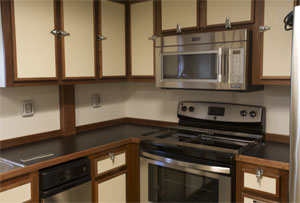 |
|
Woodwork in the galley and throughout the tug is by Matt Senecal of Brunswick, Maine. |
“This isn’t groundbreaking — BIW (Bath Iron Works) has probably done it since the ’70s,” he said. “We’re trying to implement it here on a smaller scale.”
The approach involves more outfitting earlier in the process. Pipefitters, for example, will do more of their work when the modules are still on the production floor instead of waiting until they’ve been incorporated into the vessel. The modules are more accessible and shipbuilders don’t have to vie for time and space with other workers, as can be the case when a yet-to-be-finished boat has been moved to the water.
“If it takes one hour to do it on the production floor, that same task will take three hours to do when it’s on the boat and it will take eight hours to do when the boat’s on the water,” Maddox said. “The more work we can do on the floor, the faster we can build it and the more efficient we can be in terms of labor. We’re helped in this process because we’re building a series of the same boat. It’s hard to get that much payoff with a one-off or two-off boat because of all of the planning that goes into it.”

